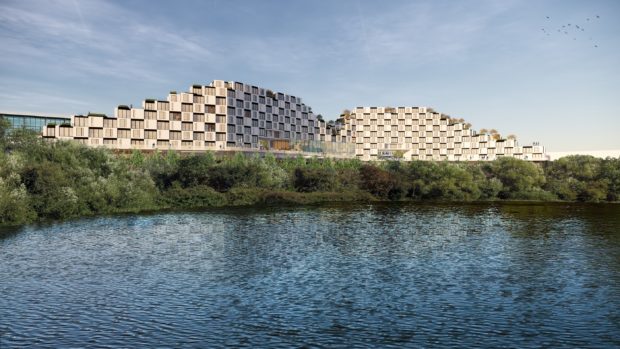A £70million project to build more than 200 flats on the edge of one of Aberdeen’s most famous sites has been thrown out – for the second time.
Developers Carttera have vowed to appeal against Aberdeen City Council’s decision to reject plans for 245 build-to-rent flats at the northern side of Rubislaw Quarry.
Planning officers had recommended the scheme for approval, despite receiving more than 425 letters of objection.
Described by protesters as looking like a “prison block”, some parts of Carterra’s Rubislaw View development would have been nine storeys tall.
Proposals included a residents-only gym, function room, public bistro and promenade above the quarry, which has been out of public sight for the last 40 years.
Councillor Martin Greig, who is on the planning committee, put forward the motion to refuse permission and later admitted he was “relieved” all his colleagues backed it.
“The proposed building is completely unsuitable for the area as it would dominate the site and be visible from near and far,” he said last night.
“The chequerboard design is totally out of keeping with such a sensitive location.
“The striking appearance might be more acceptable in a more commercial area or somewhere that will cause less visual impact.”
The Hazlehead, Queen’s Cross and Countesswells councillor, whose ward includes the proposed site, added that it was “unrealistic” for the potential tenants and visitors to rely on the area’s public transport links and said there was a “a serious lack of sufficient parking” in the proposals.
The emphatic rejection of the scheme yesterday marks a second time councillors have gone against officers’ recommendations to approve plans for hundreds of flats there.
In 2018, Carttera’s original plans for nearly 300 flats were rejected.
Again, they had been recommended for approval but councillors went with the hundreds of objectors and voted them down.
The Scottish Government reporter upheld the council’s decision upon appeal.
Before its closure in the early 1970s, the quarry earned Aberdeen its Granite City nickname as millions of tonnes of the rock was excavated from it.
Public objections were led by Hugh Black, who had plans for a heritage centre exploring the historical significance of the granite industry on the opposite side of the quarry.
As the “absolutely brilliant” news of the council rejection of the plans broke, he told The Press and Journal: “Councillors have taken the right decision and we now have a few months to prepare for the appeal.
“The government reporter did favour some elements of the previous plans and some of the changes Carttera made were to satisfy their complaints.
“But they clearly did nothing to satisfy the public opinion: categorically, a development of that size is not suitable for the site.”
Mr Greig added it was essential the local authority was in a position to defend its decision “as robustly as possible”.
Planning permission remains for a smaller 116-flat development at the site.
